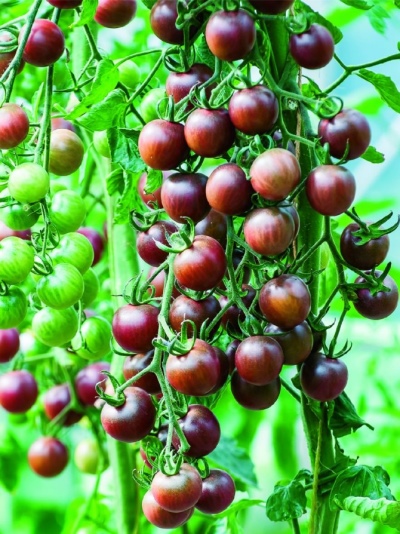
- Authors: Nastenko N.V., Kachainik V.G., Gulkin M.N., Karmanova O.A.
- Year of approval: 2015
- Category: grade
- Growth type: indeterminate
- Appointment: fresh consumption, for pickling and preserving
- Ripening period: early
- Ripening time, days: 100-105
- Growing conditions: for open ground, for film greenhouses
- Bush size: tall
- Bush characteristic: powerful
Tomato Curiosity attracts by its name. But before you are tempted by them and try to breed on the site, it would be nice to get to know him better. The planting scheme, and the growing order, and resistance to a number of dangerous factors deserve attention.
Breeding history
Tomato Curiosity appeared relatively recently. Its cultivation was officially allowed in 2015. The development of the culture was carried out by breeders Nastenko, Gulkin, Karmanova, Kachainik.
Description of the variety
The curiosity is one of the indeterminate cultures. The plant is allowed to be used outdoors. It is often grown in plastic greenhouses as well. Bushes are able to rise to great heights. They are very powerful, covered with dark green foliage.
The main qualities of the fruit
Green Curiosities have a green spot near the base. Ripe tomatoes acquire a green-brown color. They belong to the category of cherry and weigh 17-20 g. Rounded berries grow from complex inflorescences. They are covered with a thin, smooth skin.
Taste characteristics
The use of the Curiosity is possible fresh. They are also quite allowed and canned. Sweetness is typical for this plant.
Ripening and fruiting
A curiosity - early tomato. It will ripen on average 100-105 days after sprouting. After the start of collecting the fruits, it will take a long time to remove them. Sometimes the fruiting period ends only in early October. Specific dates depend on weather conditions, to a lesser extent on agricultural technology.
Yield
Fertility ranges from 6.2 to 6.7 kg per 1 sq. m. It seems to be not too much, but the quality of the harvested berries compensates for this problem. The yield is relatively stable over the years. According to some sources, the bush is capable of producing 8-12 kg of fruit per season.
The timing of planting seedlings and planting in the ground
Sowing seeds in containers should be done 60-65 days before the expected transplanting period in open ground. Specific dates are determined by personal experience. The weather forecast is taken into account.

Growing tomato seedlings is an extremely important process, because it largely depends on whether the gardener can harvest at all. All aspects must be taken into account, from seedbed preparation to planting in the ground.
Landing scheme
Up to 4 bushes can be placed on 1 "square". However, it is better to do a little less to make it easier to look after. And also a lower saturation of plantings reduces the likelihood of diseases and mutual interference with each other from the tomatoes. The holes are usually placed in a 500x500 mm system.

Growing and care
Processing of planting material with potassium permanganate is carried out three days before disembarkation in containers. The seeds are wrapped with gauze and immersed in the solution for about 15 minutes. If their origin is doubtful, you can increase the processing up to 30 minutes. It is not recommended to do it even more, because there is a great risk of causing irreparable harm. After processing, the seeds should be thoroughly rinsed with running water.
For planting seedlings, only carefully selected and disinfected (calcined) soil should be used. Calcination is carried out for 20 minutes at a temperature of 200 degrees. Seedlings will grow stronger in 30-45 days if their agricultural technology is completely correct. The soil should be loose and relatively moist. The normal content of mineral and organic substances is very important.
Pegs are driven in near each recess. The planted seedlings are sprinkled with earth and compacted a little. It is best to plant plants where onions or cabbage used to be. The fastest ripening is achieved when the plant is formed into 2 or 3 stems. Watering and feeding are applied in the same way as for other varieties.




A plant needs different micronutrients at each stage of growth. All fertilizers can be divided into two groups: mineral and organic. Folk remedies are often used: iodine, yeast, bird droppings, eggshells.
It is important to observe the rate and period of feeding. This also applies to folk remedies and organic fertilizers.


Growing regions
Dikovinka tomatoes are recommended for gardeners of the North-West and Siberia, the Urals and the Volga region. They can give a good result in the Far Eastern gardens. The North Caucasian territories and republics are also becoming an excellent base for growing Curiosities. She is also met in the Lower Volga region, in the center and in the north of the European part of Russia. And it is also allowed to use Dikovinka tomatoes in the Central Black Earth Region.

























































































